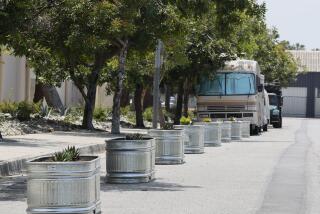WESTLAKE : Architecture Class Does Home Work
- Share via
Just before Christmas, 12 USC architecture students and two architects built five wooden shelters, each 7-by-2 1/2 feet, and gave them to two men living in less sturdy quarters beside a freeway ramp west of Downtown.
The builders called it guerrilla architecture for the homeless. For Larry, one of the men living in the shelters, it means a chance to stay dry and warm.
The idea for the shelters grew out of discussions that Christopher Jarrett, an architect and instructor in the USC School of Architecture, had with students about homelessness in Los Angeles. The shelters they built cost about $50 each for the wood, corrugated plastic and other materials.
“We realized that there are larger issues that we can’t solve now, but we can deal with the instant need,” said student Krisztina Tokes.
Said student Han Chung: “We tried to think about what kind of shelter we would want if we were homeless.”
Designing and building the shelters was easier than delivering them, the students said.
Initially, they hoped to place the shelters in the Downtown area where they would be useful--and a visible reminder of the inadequacy of government efforts to address homelessness, Tokes said.
But several people living on the streets told the students that the shelters would be quickly dismantled by authorities.
After a search for encampments away from Downtown, they found a site with two willing recipients who promptly covered and altered the shelters to make them less visible.
“Reality dictates camouflaging,” Tokes said.
Larry, who declined to give his last name, was concerned Caltrans would remove the structures, which he said are better than his previous dwelling fashioned mostly from cardboard and garbage bags.
“It keeps the rain out. That’s the main thing right now,” he said. “The floor’s also up off the ground so it’s not as cold.”
Student Doug Kim said the project made him realize the complexity of the homeless problem and the need for more people to work on solutions.
Jarrett called the project “a steppingstone” in the students’ education and toward other projects designed to contribute to the city’s rebuilding.
More to Read
Sign up for Essential California
The most important California stories and recommendations in your inbox every morning.
You may occasionally receive promotional content from the Los Angeles Times.













